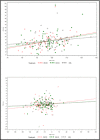Olmesartan improves pulse wave velocity and lowers central systolic blood pressure and ambulatory blood pressure in patients with metabolic syndrome
- PMID: 25537177
- PMCID: PMC8032153
- DOI: 10.1111/jch.12458
Olmesartan improves pulse wave velocity and lowers central systolic blood pressure and ambulatory blood pressure in patients with metabolic syndrome
Abstract
Ambulatory blood pressure (BP) and central systolic BP (cSBP) are superior to brachial office BP measurements in predicting cardiovascular end organ damage. The authors aimed to analyze the effect of olmesartan 80 mg (OLM 80) vs 20 mg (OLM 20) vs amlodipine 5 mg (AML 5) on central hemodymamics and ambulatory BP in patients with metabolic syndrome (MetS).In a double-blind, three-phase crossover study comprising 69 untreated patients with MetS defined by the Third Report of the Expert Panel on Detection, Evaluation, and Treatment of High Blood Cholesterol in Adults guidelines, the effects of OLM 80 on central hemodynamics (cSBP), central pulse pressure), pulse wave velocity (PWV), and 24-hour ambulatory BP were compared with OLM 20 and AML 5, given for 6 weeks each. In 69 patients (47 men, 22 women) (51.5±9.75 years), reduction in cSBP was the highest with OLM 80 and significantly greater than the reduction with AML 5 (-14.1 mm Hg vs -9.7 mm Hg, P=.0117). All three substances significantly reduced 24-hour ambulatory systolic (OLM 80 and OLM 20 P<.0001; AML 5 P=.0105). BP and 24-hour diastolic BP (OLM 80 and OLM 20 P<.0001; AML 5 P=.0126). PWV was significantly reduced by OLM 80 (-0.58 m/s, P=.0088) and by OLM 20 (-0.48 m/s, P=.0362) but not by AML 5 (-0.28 m/s, P=.2065). For PWV, no significant differences were detected between the three groups. OLM significantly improves arterial stiffness as demonstrated by the reduction in PWV and in cSBP. In addition, 24-hour ambulatory BP was reduced to a greater extent with OLM 80 than with AML 5.
© 2014 Wiley Periodicals, Inc.
Figures



Comment in
-
Effects of treatment on arterial stiffness and central blood pressure--points to consider.J Clin Hypertens (Greenwich). 2015 Feb;17(2):105-6. doi: 10.1111/jch.12477. Epub 2015 Jan 13. J Clin Hypertens (Greenwich). 2015. PMID: 25641094 Free PMC article. No abstract available.
References
-
- Dekker JM, Girman C, Rhodes T, et al. Metabolic syndrome and 10‐year cardiovascular disease risk in the Hoorn study. Circulation. 2005;112:666–673. - PubMed
-
- Wang J, Ruotsalainen S, Moilanen L, et al. The metabolic syndrome predicts cardiovascular mortality: a 13‐year follow‐up study in elderly non‐diabetic Finns. Eur Heart J. 2007;28:857–864. - PubMed
-
- Miyashita Y, Saiki A, Endo K, et al. Effects of olmesartan, an angiotensin II receptor blocker, and amlodipine, a calcium channel blocker, on Cardio‐Ankle Vascular Index (CAVI) in type 2 diabetic patients with hypertension. J Atheroscler Thromb. 2009;16:621–626. - PubMed
-
- Smith RD, Yokoyama H, Averill DB, et al. Reversal of vascular hypertrophy in hypertensive patients through blockade of angiotensin II receptors. J Am Soc Hypertens. 2008;2:165–172. - PubMed
-
- Schiffrin EL. Effect of antihypertensive therapy on small artery structure in hypertensive patients. Hypertension. 1995;26:716–718. - PubMed
Publication types
MeSH terms
Substances
LinkOut - more resources
Full Text Sources
Other Literature Sources
Medical
Miscellaneous

